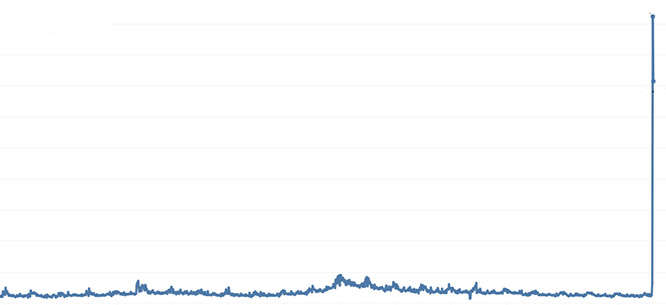The Unemployment Shock
The Unemployment Shock
Most downturns in the business cycle occur over a number of months. This spike has occurred in just a couple of weeks.

[contentblock id=coronavirus]
The U.S. Department of Labor released the count of new weekly claims for unemployment insurance today. The new numbers are staggering, not just for their scope but for their suddenness. Most downturns in the business cycle occur gradually over a number of months; this spike has occurred in just a couple of weeks. These numbers are the best economic metric we have in this unfolding crisis, providing us a near real-time measure that the forthcoming April jobs report (whose reference point is March 12) will largely miss.
The national total of new claims for the week ending March 21 was 3.28 million, almost five times the previous peak in weekly claims, recorded in 2009 during the Great Recession. Last week we added another 6.65 million new claims—a total ten times the previous peak. These numbers understate the true scale of the damage. Those ineligible for regular unemployment insurance—including the self-employed, gig workers, independent contractors, and new entrants to the labor market—do not show up in the claims data, although this will change once the federal Pandemic Unemployment Assistance program kicks in. The underemployed, hanging on to whatever hours they can get, are also uncounted here.
By one estimate (using projections of a 9 percent contraction in the economy for the first quarter, and a further 34 percent reduction in the second quarter), job losses by July will approach 20 million—yielding a national unemployment rate of just under 16 percent. A back-of-the-envelope estimate by the St. Louis Federal Reserve (based on expected “social distancing” layoffs in contact-intensive occupations) puts the second quarter unemployment rate at over 32 percent.
Just as alarming are the state numbers. In the chart below, weekly claims data is plotted, by state, from 1987 to the most current report (the data is a little noisy, because the state numbers are not seasonally adjusted). Off-the-charts rates of new claims over the past two weeks (the March 21 and March 28 new claims indicated by the data labels) are evident in almost all states—but especially in those with a high share of leisure and hospitality workers (see Nevada) and those hard hit by the pandemic itself (see Washington). California logged 186,000 new claims in the week ending on March 21 and added almost five times as many (878,000) this week. New claims in Louisiana spiked on March 21 to the same level (over 70,000) as those made in the immediate wake of Hurricane Katrina—and this past week added another 97,000 claims.
Colin Gordon is a professor of history at the University of Iowa. He is the author of, most recently, Growing Apart: A Political History of American Inequality and Citizen Brown: Race, Democracy, and Inequality in the St. Louis Suburbs.




